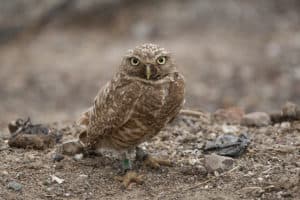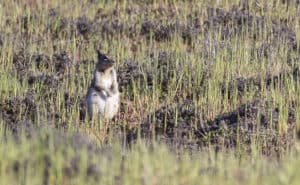Share this article
Translocating pesky squirrels can help declining owls
One person’s annoyance can be a declining species’ treasure.
Wildlife managers are putting squirrels that are a nuisance to ranchers and other landowners to work in engineering ecosystems where burrowing owls can thrive.
“When we do conservation, we often are focused on the endangered species or the listed species,” said Ron Swaisgood, Director of Recovery Ecology at San Diego Zoo Institute for Conservation Research and one of the co-authors of a study published recently in Animal Conservation. “But there’s a role in conservation for the more common wildlife — especially those species that are ecosystem engineers.”
Western burrowing owls (Athene cunicularia hypugaea) face increasing pressures of habitat loss and the declining suitability of landscapes they once used. Conservationists with the San Diego Zoo have been working for about 10 years on reintroducing the owls to more optimal locations. But while most people wouldn’t want holes in their plans, these managers needed them. Burrowing owls don’t excavate their own holes, so the wildlife technicians have been digging artificial burrows. The trouble is, these don’t last long, and they don’t provide a long-term, sustainable solution.
California ground squirrels (Otospermophilus beecheyi) used to dig holes that owls would then use for their burrows, but the squirrels are now absent from many of the areas due either to persecution or the invasion of dense Mediterranean grasses that create unfavorable habitat.

The western burrowing owl faces pressure due to habitat loss. Courtesy San Diego Zoo Global
Swaisgood and his colleagues wanted to see if they could pass the conservation job on to squirrels, but they weren’t sure if the plan would work.
“If you really want to get that habitat created, it’s much quicker and more effective to translocate the squirrels,” he said. “We’re always looking for ways to create more sustainable ecosystems that require less input for human managers.”
Between 2011 and 2013, they brought in 707 squirrels translocated from areas where landowners weren’t thrilled with their presence since the holes they dig can negative impact ranch land for livestock. They had no problem finding sources.
“We were giving these squirrels a second chance,” Swaisgood said.
They divided up nine release areas into three different sections: areas in which the invasive grass had been mowed, areas where the grass had been removed that also had starter holes, and areas in which the grass was left intact.
About a year later, they found that not all squirrels had stuck around the study area. But the ones that did had dug over a thousand burrows in the experiment area.
“They pretty much abandoned the control area because the grass was too dense,” Swaisgood said. But, he said, the squirrels seemed to like the other two types of landscapes. They especially liked the area with starter holes, but they didn’t actually use the starter holes. Swaisgood said the squirrels may have been attracted to these areas because it looked like other squirrels had been using them.

California ground squirrels help burrowing owls by digging burrows they need for nestingCalifornia ground squirrels help burrowing owls by digging burrows they need for nesting. Courtesy San Diego Zoo Global
The team also found that soil type seemed to matter. The squirrels took up residence in sandier areas easier for burrow digging, and they tended to avoid soils with more clay.
Swaisgood said the success of setting up squirrel colonies has already paid off for burrowing owls, though this work is ongoing. Currently, he and his colleagues are translocating the birds to some of the areas where the squirrels have dug burrows, and some of the owls are even breeding.
Not only do the squirrels lighten the work load for wildlife managers, but the squirrels are also probably better at selecting areas that are suitable for burrowing owls.
“When we put in artificial burrows, we risk selecting areas that might otherwise be unsuitable for owls,” Swaisgood said, adding that the areas they choose may have owl predators or other issues.
Their work demonstrates why it’s important to conserve species that may not face immediate conservation threats, Swaisgood said. While California ground squirrels are still common, they are likely down to 20% of their historical numbers. This drop in their population can have secondary effects on other species — like burrowing owls — that depend on the services they provide as ecosystem engineers.
Header Image: California ground squirrels are considered pests by some, but they perform necessary ecosystem functions. ©Allan Hack








